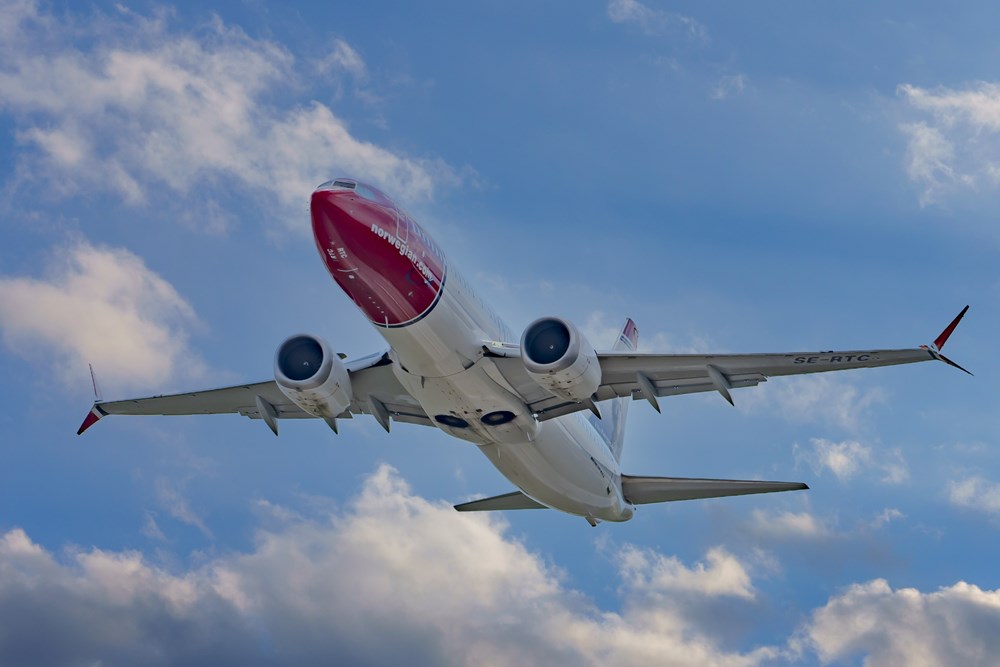Scandinavian carrier Norwegian is considering extending leases on some of its existing fleet as it braces for further aircraft delivery delays next year.
Norwegian, which ended 2022 with a fleet of 70 aircraft, had been hoping to lift this to 85 this summer as it adds Boeing 737 Max jets to an existing fleet of largely 737-800s.

Source: Vladimir Prokop/Shutterstock.com
Norwegian will operate a fleet of 81 aircraft in summer 2023, comprising a mix of Boeing 737-800 and Max jets
However, new aircraft delivery delays amid the wider ramping-up and supply challenges aircraft manufacturers continue to grapple with mean Norwegian will only operate 81 aircraft this summer – a figure it was able to achieve only after the recent agreement with Air Lease to lease six Boeing 737 Max jets formerly flown by collapsed rival Flyr.
"We have some challenges, mostly due to the fact Boeing and Airbus are struggling to deliver aircraft these days,” Norwegian chief executive Geir Karlsen said during a fourth quarter results briefing today.
"Looking at the delivery schedule today, we will not be surprised if we have some delays. So what we are doing is considering to extend leased aircraft that we are currently flying past their redelivery dates, just to ensure we have the fleet we need, at least for the next two to three years."
Norwegian has 50 Max jets on order from for delivery between 2025-28 and options on a further 30 to arrive before 2030.
"We have taken delivery of one Max in January, we are taking two in February, one in March and one in May and that’s all,” he says of deliveries this year, excluding the recent Air Lease deal.
"We might have deliveries in the fall. We don’t like to have deliveries into the fall, we like to have them in the spring, so that is a discussion we will have with the leasing companies as well as with Boeing. Will there be a risk of delays into 2024? Yes. This is not over in 2023, it will continue into 2024 and that is why we are considering to extend the leases we currently have to ensure we have the fleet we need and the growth we are planning for the next two to three years.”
Norwegian’s fleet is set to dip to 77 this winter under its current plan as existing aircraft come off lease.
The increase in fleet, albeit not as big as originally envisaged, will support an increase of a quarter in its capacity this year versus 2022. "We are bringing in 11 aircraft this summer, they will mostly be split between Norway and Denmark, not so much in Sweden and Finland," Karlsen says. "If you look at the capacity we are putting in, it is a mix between new destinations. And the new destinations will be split 50% cities, and 50% leisure.”
However, while Norwegian will go ahead with its plan to open a seasonal base at Barcelona this year, the smaller fleet plan means a move to expand into Latvia is on ice. "We were meant to be opening a base in Riga, which was meant to be the first step outside of the Nordics again. Unfortunately, and this is only due to delivery issue we have with Boeing, we will postpone that base opening at least for now. But hopefully we can get going again in 2024,” Karlsen explains.
Norwegian, which heavily restructured and put its operations ‘in hibernation’ during the pandemic, returned to profit in 2022. While the carrier slipped back to a loss in the fourth quarter, where the low-demand season was compounded by higher fuel costs and the impact of a weak currency against the US dollar, Karlsen highlights the flexibility it showed in reducing capacity by between 20-30% during this period.
"We have [in Q4] been able to keep a steady load close to 80% as well as a yield that is probably not good enough, but it’s steady and where we had expected it to be,” he says.
Karlsen also flags a strong demand and yield outlook. "[Our] new year sales campaign sold more than 1 million tickets in two weeks, more than double last year. And even more important we are selling at 22% higher yield than last year. [It’s] very encouraging and even more encouraging, the sales activity has continued after the sales campaign. And it is across the network.”
This has prompted Norwegian to guide for an increase in unit revenues for the coming year. "We are not exact in the number, but we are certainly guiding a higher unit revenue,” he says.
Karlsen sees little competitive impact from the recent collapse of Norwegian start-up Flyr. "We don’t really see that many changes. If we are seeing anything, we are seeing the closest competitor SAS is flying more than us in capacity. We have chosen to fly less,” he says. Beyond that he says some rival carriers are not putting in as much capacity as anticipated. "So if anything its probably less of the competitors coming in if you compare it with six months ago,” he says.
A bigger cloud on the horizon remains high fuel prices and exchange rate impacts, which dented the airline’s fourth quarter performance. "We just have to make sure we do whatever we can to keep the costs down. That’s why we have set a target, which we believe is realistic, in 2023 to reduce the CASK [excluding fuel] by 5-10%,
“We have to realise that due to inflation and increased interest rates, and due to high oil price and the relatively weak Krone compared to the US dollar, we are under pressure. But that applies to everyone. We just have to make sure we do the best out of it,” Karlsen says.


























